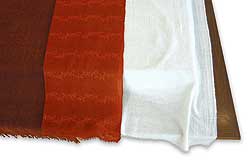 Some winter and all the best-dressed shoulders in the world are wearing Nepali pashmina. Despite the glut in the market and erosion of the earlier euphoria over the fabric, it is still a glamorous alternative with enough exoticism to bump off other options. Things are exotic as long as they are exclusive, but if they remain exclusive then it can't be a fad-it's a fine balance.
Some winter and all the best-dressed shoulders in the world are wearing Nepali pashmina. Despite the glut in the market and erosion of the earlier euphoria over the fabric, it is still a glamorous alternative with enough exoticism to bump off other options. Things are exotic as long as they are exclusive, but if they remain exclusive then it can't be a fad-it's a fine balance. Pashmina connotes a certain elitism and luxury, but it is surprisingly affordable, especially here in Nepal. High international demand has plumped up manufacture, which has caused prices to settle at very comfortable rates. Comfortable enough for women like 35-year-old Pushpa Sharma, a businesswomen, to own 50 shawls in various weaves and colours.
"A modern woman's wardrobe is incomplete without pashmina," she says of this extraordinarily light, soft and warm fibre. "I can't go anywhere without it, and no, I don't believe pashmina is a rich woman's prerogative." Quality determines prices so pashminas can be had for as little as $20 or as much as $250 for A-grade 100 percent stoles and shawls.
The reason for its popularity has much to do with versatility. Men in London this winter are wearing pashmina scarves with their tuxedos for a touch of flair, women team it up with everything from floaty dresses to jeans. In Nepal, every bride has at least three pashminas in her trousseau. Like the sari, the pashmina is kind to the wearer: it drapes, flatters and infuses style into the dullest outfit.
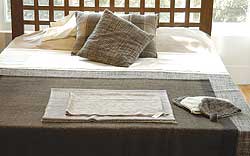 What cashmere is to the West, pashmina is to the East. And the twain meet between Kashmir and Kathmandu. In India, and later in Nepal, pashmina was reserved for royalty, but it didn't take very long for it to come to the attention of the luxury loving European imperial families. Around the 18th century, the governor of Kashmir presented a pashmina to a visitor from Baghdad who gifted it to Egyptian nobility. The pashmina then made its way to Napoleon Bonaparte who gave it to his wife, Empress Josephine. Trust the French to recognise a good thing. The empress immediately asked for more in every conceivable colour, starting the First European Pash Boom.
What cashmere is to the West, pashmina is to the East. And the twain meet between Kashmir and Kathmandu. In India, and later in Nepal, pashmina was reserved for royalty, but it didn't take very long for it to come to the attention of the luxury loving European imperial families. Around the 18th century, the governor of Kashmir presented a pashmina to a visitor from Baghdad who gifted it to Egyptian nobility. The pashmina then made its way to Napoleon Bonaparte who gave it to his wife, Empress Josephine. Trust the French to recognise a good thing. The empress immediately asked for more in every conceivable colour, starting the First European Pash Boom. Fast forward to the early 1990s. Western haute couture suddenly rediscover pashmina and fashion designers and editors go into hyperbolic raptures: "diamond fibre", "soft gold of Asia", "Rolls Royce of clothing", "king of wool", "fibre of the Gods". The spiel worked extremely well for what is essentially goat hair. But such hype rarely lasts.
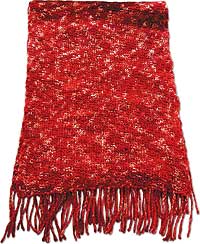 Pashmina, derived from the Persian word 'pashm' meaning cloth, comes from mountain goats that live above 3,300m. Pashmina is the goat's soft underbelly down, which lies under the coarse outer hair. The goats shed each spring and the hair is either collected or combed from the goats. The fibre is sorted, cleaned and spun into yarn, woven and then individually dyed and dried. (This is cruelty-free fashion, unlike shahtoosh that is made from the endangered Chiru, or Tibetan antelope. An average of 20 Chirus are killed for one shawl that commands as much as $2,500 on the blackmarket.)
Pashmina, derived from the Persian word 'pashm' meaning cloth, comes from mountain goats that live above 3,300m. Pashmina is the goat's soft underbelly down, which lies under the coarse outer hair. The goats shed each spring and the hair is either collected or combed from the goats. The fibre is sorted, cleaned and spun into yarn, woven and then individually dyed and dried. (This is cruelty-free fashion, unlike shahtoosh that is made from the endangered Chiru, or Tibetan antelope. An average of 20 Chirus are killed for one shawl that commands as much as $2,500 on the blackmarket.) The Nepali pashmina industry owes its success to the Gurung and Thakali communities from the mountain areas that brought the fabric to Nepal centuries ago. When these hill people moved to Kathmandu they discovered their craft had money-making potential and started selling to the local market. When tourism grew, more families started small pashmina manufacturing outfits. Scattered shops soon became big manufacturing companies and by 1997 Nepal was exporting Rs 3 million worth of pashminas. By 2000 that figure was Rs 5.6 billion.
"I had forecasted that pashmina would hit the international market on a large scale when the fashion industry was on a high and pashmina was in much demand," says Pushpa Shrestha of Nepal Pashmina Industry, one of the largest Nepali exporters. He was a forerunner, starting with just Rs 2,000 as capital in the early 80s. The company's annual turnover today is over Rs 3 million.
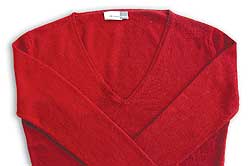 "It was a dream come true," says Gopal Das Manandhar of Euro Pashmina, another big exporter and among the oldest families involved in the trade. It was a struggle for his family when they began Manandhar Brothers 40 years ago. The company folded but two decades later, Manandhar revived the family business by starting his own company, which is now one of the most successful in the business.
"It was a dream come true," says Gopal Das Manandhar of Euro Pashmina, another big exporter and among the oldest families involved in the trade. It was a struggle for his family when they began Manandhar Brothers 40 years ago. The company folded but two decades later, Manandhar revived the family business by starting his own company, which is now one of the most successful in the business. After 2000, the industry went into a deep slump, falling to Rs 1 billion last year. But pashmina entrepreneurs still hope it will pick up. "Nepal's international market has not deteriorated. It's just that we need to move with the international trend of fashion," says Manandhar. With China emerging as Nepal's biggest competitor, entrepreneurs are feeling the heat. Chinese labour is cheaper, the production cost is low, their manpower is better skilled and they have their own raw material, something that Nepal imports.
"The thing that works in our favour is that the Europeans have a soft corner for us and we have already established goodwill among our clients," says Shrestha who adds that there is really nothing to worry about. With China and India cutting in on the pashmina pie, Nepal has to stay ahead by being creative and innovative. "If we want continued success, we have to be more creative in design, styling and getting colour combinations right," says Shrestha.
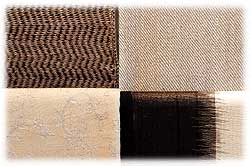 The problem is that Nepal doesn't have institutions to survey foreign markets or specialise in design and style. This is where young entrepreneurs like Meghna Thapa and Sapna Bajracharya step in. A year ago, both designers in their mid-20s put their savings in to establish Weaves & Blends to produce creative designer pashmina items, on display at their Kumari Pati showroom, easily one of the most impressive in the Valley.
The problem is that Nepal doesn't have institutions to survey foreign markets or specialise in design and style. This is where young entrepreneurs like Meghna Thapa and Sapna Bajracharya step in. A year ago, both designers in their mid-20s put their savings in to establish Weaves & Blends to produce creative designer pashmina items, on display at their Kumari Pati showroom, easily one of the most impressive in the Valley. Starting with a small loan from their friends, Thapa and Bajracharya prove that pashmina is still fresh. They have 27 staff, a financial controller and have held an exhibition at a prestigious Parisian tradeshow. Innovation is the key to their success and Weaves & Blends moves far beyond the ubiquitous shawl-the sweaters, mattresses, jackets and hats come in new textures and colours, justifying discrete price tags that climb past $200. Says a self-assured Bajracharya: "As Nepalis, we're on par if not much better when it comes to pashmina fashion."


